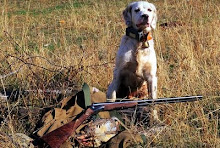
A few months ago I was having problems with steadiness in my two "broke" dogs at field trials. Both Jane and Abbi were almost flawless in training, but when it came time to pull off the collar and compete they were ripping and tearing; they had both become collar-wise and disrespectful. In Abbi this was to be expected; she's a young dog and needed to test me. Jane, on the other hand, just needs to "keep" testing me. It is quite possible that in training, on occasion, I had given them an inch, but at field trials they were taking a mile. In a trial, Abbi would generally bust birds at great distances, or out of sight, and then keep hunting as if nothing had happened. Jane would, and still will, take out birds whenever she feels like it. Part of this problem I associated with a lack of obedience around the kennel, and me not asserting myself as the pack leader. An example is, when I would let them out of their kennel to put in harness for a roading session they would run amok, not coming to my call until they were ready. I realized I needed to gain their respect but do it through different means than I had in the past; basically, the e-collar was not going to be the number-one means of correction, either around the kennel or in the field, and I was not going to ask twice for a response. For a month, when I took dogs out of the kennel it was individually. The e-collar was worn but the instrument of correction was the pinch collar or a flushing whip, sometimes a combination of both. At times I used a buggy whip, as an extension of my arm, to keep them at heel, just to change-things-up; to keep them thinking, "what's he have in store for me next if I don't behave". I wanted to get it into their brain that I had many different tools to get them where they needed to be, and any of them could be used at any time. The basics were instilled again: here, heel, and whoa. Board- and bench-work were revisited. Corrections were made for very minor offenses, letting them know that disobedience would not be tolerated. Once I was confident that the girls understood the program, and I had made several corrections with each tool, I started using my methods of correction in their bird-work. First at the very fundamental level with pigeons, then in actual horseback situations with game birds. The foundations of their training were taken apart and put back together brick-by-brick. Basically, I re-broke them both. It appears as though I have regained Abbi's full respect and control, as she has handled very well in the last few stakes I have run her. Jane on the other-hand was good for three trials and has reverted to her hard-headed ways so, more and continuous training.....









1 comment:
Jared
Seem like training never stops! I like the idea of a 'change up' to get their attention.
Seems like, as they get older, they become more independent and will try to assert themselves in various ways. If they get away with badness once, they start to try for a little more. I have seen this in my dogs from time to time and found that, as much as anything, withholding rewards and firm correction work wonders. Carrot and stick approach.
Post a Comment